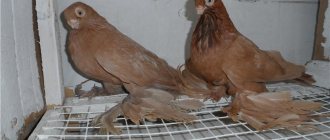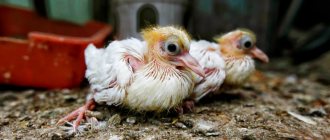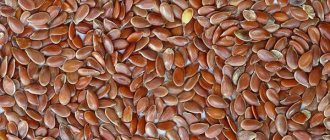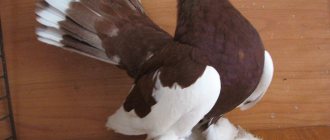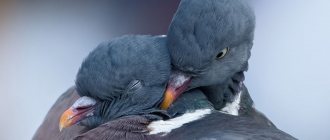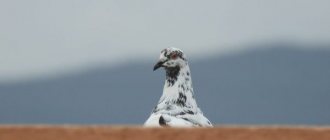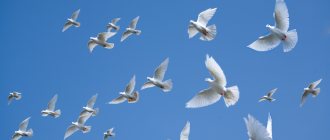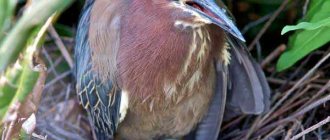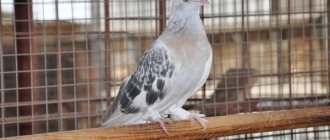Poultry farming » Pigeons
1
1571
Article rating
Kira Stoletova
Among the birds that are popular among modern breeders, one of the most prominent places is occupied by Thurman pigeons, birds primarily known for their impressive flight characteristics. Capable of performing incredibly complex aerial stunts, these acrobat birds are deservedly prized both in Russia and far beyond its borders. Another, primarily foreign, name for these pigeons is roller pigeons, and in the CIS they are often called tumbling pigeons.
Pigeons Thurmans
It is also noteworthy that today the number of Thurman breeds is in the dozens, and a huge variety of their spectacular photos are presented on the World Wide Web.
General characteristics of Thurman pigeons
High-flying tumblers have become famous for their unusual flying skills, unlike other species.
Thurmans, or roller skates as they are called abroad, are capable of performing various flips in the air. Because they fly for a long time and often - the individuals are strong and hardy. In the air, adult birds fly in small groups. Breeders note that this is how birds compete in their skills. During one flight approach, the pigeon demonstrates about 4-6 somersaults, then sits down to rest. All types of pigeons were divided by scientist Charles Darwin into four groups. Turmans are part of a heterogeneous group, along with peacocks, English gulls, Indian and English turbines.
https://www.youtube.com/watch?v=VIDEO_ID
High-flying tumblers are characterized by a wide variation in feather color, appearance, general parameters, as well as the style of elements during flight. Most birds of the breed have a rather small head, as does the body itself. Basically, the total weight of an individual is 760-850 grams. The eyelids are light, the eyes, on the contrary, are of a very dark shade.
The English tumbler combines decorative and flying qualities
Thurmans are a remarkable breed of pigeon. They are distinguished by dexterity of movements during flight and low weight. They are especially good at somersaults in the air. However, this requires that breeders conduct constant training with them. Tumblers have many variations in color, appearance and flight styles.
The main characteristic features of these pigeons are as follows:
- body: small;
- weight: no more than 800 g;
- beak length: medium or small;
- forehead: high;
- neck: long;
- eyes: large;
- color: dark;
- chest muscles: powerful;
- wings: long;
- tail: wide.
A distinctive feature from other breeds is the wide distance between the legs.
Key Features
As mentioned above, the main advantage of Thurman pigeons is the beauty of their flight. Particularly interesting is the fact that representatives of some breeds can rise to a truly enormous height for pigeons: up to 500-600 m, and sometimes even more. At the same time, breeders pay special attention to another point: the flight style of Thurman pigeons, focusing on its complexity and originality.
Representatives of various breeds of these birds began to be bred quite a long time ago: in the 17th century, through crossing based on racing and high-flying pigeons. It is worth recognizing that the efforts of the specialists turned out to be entirely justified, because they managed to obtain many breeds, the representatives of which are able to organize real flight shows. If we list the most significant features of tumbler pigeons, their list will look like this:
- rather modest appearance, which in some cases can be called nondescript;
- compact body dimensions;
- a small head, which may be decorated with a forelock (depending on the breed);
- medium or short beak length;
- high forehead and elongated neck;
- large eyes with a dark color;
- light, almost white eyelids;
- powerful pectoral muscles;
- long wing length;
- a wide tail with about 13 tail feathers.
Regarding the body weight of the pigeons in question, it should be noted that it is relatively large: about 800 g. Another characteristic feature of the Thurmans is the wide arrangement of their small legs, which can be clearly seen in the photo of these feathered aerobatics masters.
The price of the pigeons presented in this material also deserves attention. In general, it cannot be called democratic, which is primarily explained by the prestige of the Thurmans, which has been consistently high for many decades in a row.
Flight qualities
Thurman pigeons have their own characteristic features in each variety of this breed. But for all representatives, it is typical to spend a long time at high altitudes and perform various maneuvers - somersaults and inversions. It is worth emphasizing that such complex elements are not “too tough” for every bird.
Usually Odessa pigeons fly in groups, as if competing in their skills. After which they sit down to rest and soar up again. These birds are in flight most of the time; they are physically strong and resilient. During one flight, an individual can perform 3–5 different flips.
Thurmans are known throughout the world for their flying skills. In the West, they are called “rollers” because of their ability to perform flips in the air. Most often they can be seen in the sky in small groups - breeders are sure that this is how they compete. During one flight, a bird can make up to 6 somersaults, after which it needs time to rest.
Did you know? In the 17th century, an analogue of gunpowder was made from pigeon droppings. At that time, King George I of Great Britain declared all pigeon droppings in the country to be the property of the crown and obliged citizens to collect it.
Origin
A variety of decorative pigeons, known under the common name “tumbler”, is a high-flying poultry. The name of this group comes from the word "tour", which in French means "to tumble" or "to move in a circle." Indeed, the main thing that distinguishes Thurman pigeons from their counterparts is liveliness, activity and the ability to perform various tricks in the air.
The exact origin of this lineage of birds is unknown. Breed researchers hold opposing points of view:
- According to the first theory, the roots of the tumblers should be sought in the ancient Persian state. According to historical sources, local residents bred this type of pigeon. Modern representatives of the breed descend precisely from the ancient “Persians”.
- According to another version, it is impossible to accurately determine the country of origin. The variety was grown in many ancient states. And birds came to Europe from the Roman Empire.
Most zoologists adhere to the second hypothesis. It is confirmed by a large number of varieties and intrabreed types. In the modern world, these domestic birds are called differently. For example, in CIS countries, tumblers are called paduns or vertuns. And in European countries the name “rollers” is common.
Russian ribbon tumblers
Banded red-spotted tumblers are the first breed of this type in Russia. It was most likely obtained by crossing local red pigeons with Iranian and Turkish slaughter pigeons. It got its name because of the white ribbon on its tail. The breed was officially registered in 1901.
Russian ribbon tumblers have a medium-sized body. The head is small, dry, with a steep, wide forehead. The eyes are dark with white eyelids. The beak is short and plump. The breast is convex, the wings are long, reaching to the ground, the tail is slightly raised and fluffy.
Read more: Citrus Calamondin growing a houseplant at home
The coloring of pigeons is interesting, combining red and white shades. The chin, cheeks, abdomen, groin, thighs are white. The tail, wing, neck, back are red. There is a crest on the head that covers the back of the head; there are individuals without it.
Red-spotted banded tumblers fly low. In the air they somersault over their heads and can spin like a wheel. Unfortunately, this breed is increasingly being grown as an ornamental breed and is kept in enclosures without flying. Therefore, many birds have lost their flying qualities. Ribbon tumblers are excellent parents, easy to care for, and even novice poultry keepers can keep them.
Flight
When domestic tumbler pigeons fly into the sky, it is not just a spectacle, but a whole show. They soar upward in a column. And then the smooth circling and acrobatic tricks begin. This performance looks especially good if there is a flock of birds in the air, rather than single birds. As already mentioned, they fly in groups. Therefore, experienced breeders always try to breed young birds with more experienced birds. A real competition begins in the sky, with each pigeon trying to show the others their best somersault. This is how their skills are honed and improved. Let's look at what types of tumblers are the most popular today.
Varieties
Today ornithologists know 100 varieties of this breed.
Birds are divided according to the following criteria:
- beak length;
- colors;
- the presence of a forelock or tuft.
Let's look at a detailed description of the most common tumblers.
Tape
These tumblers got their name because of the white stripe at the end of the tail. The classic plumage color is red, but there are other colors.
Distinctive features are as follows:
- small head and body;
- wide forehead;
- the presence of a crest;
- dark-colored pupils, light-colored eyelids;
- the beak is short and at the same time quite thick;
- the wings reach the ground;
- the tail is fluffy and slightly raised up.
Ribbon tumblers fly at a low altitude, with frequent flips over the head and various rotations.
Kursk
These birds are the result of crossing breeds such as the Borodun, the Nikolaev Cloudcutter and the Ribbon Tumbler. Their flights are distinguished by grace, they are considered natural acrobats.
- large black body;
- the chest is large;
- muscles are developed;
- the wings are quite large, their color is white;
- the tail is wide.
Kursk tumblers were bred in a natural environment, with minimal involvement of breeders.
Orlovsky
No reliable information has been preserved about the origin of the Oryol tumblers. Purebred representatives have a completely white color - dilution with other colors is considered a defect.
Other features:
- body is small;
- short beak;
- the head is small;
- forehead protrudes forward;
- dark colored eyes;
- eyelids give off a bluish tint;
- the body is elegant;
- the neck is long;
- fluffy tail.
Kishinevskie
These pigeons have the following distinctive features:
- body color ranges from brown and cherry to black;
- the tail and edge of the wings are white;
- larger body;
- the beak is longer and wider than others;
- the head is small;
- large eyes with white eyelids.
Odessa
Odessa Turmans have excellent flight qualities, are well oriented in space and are attached to their home. With regular training, these pigeons can fly for a long time, while demonstrating beautiful tricks.
Important! To prevent birds from losing their flight qualities, it is strictly forbidden to mate pigeons through inbreeding. In addition, the chicks born from such a union will get sick and grow poorly.
- cone-shaped body, medium size;
- the head is slightly pressed down from above;
- proud posture;
- the wings are long and strong;
- legs without feathers, with white claws;
- The plumage is velvety, shimmering with mother-of-pearl.
Volskie
Pigeons of this species can fly for up to 8 hours. At the same time, they are extremely low maintenance.
These birds are characterized by the following indicators:
- the physique is strong;
- the neck is wide;
- the chest is large;
- round head;
- the beak is strong;
- resin color, with chaotic white patches.
Tula
The Tula variety of tumblers has not changed since its appearance. In the old days it was widespread. These birds like to fly at medium altitudes, rising upward in even circles.
They have the following qualities:
- plumage color is dark red;
- white spots decorate the tips of the wings and tail;
- the feathers have a lilac tint.
Bryansk
A little-known variety of tumblers. Gain good height by moving in circles. During one flight they can perform up to 5 somersaults. The flight duration reaches 6 hours.
The characteristics are as follows:
- color from white to darker;
- tall;
- there is a crest on the back of the head;
- wings are lop-winged;
- the tail is wide.
Video “Oryol Cresteds in a private nursery”
Russian Oryol tumblers are another ancient breed, bred in the 18th century in Oryol. The plumage color of the birds is exclusively white; there is a small crest on the back of the head. Oryol tumblers are short-billed; as a result of crossing with gulls, the beak has become almost invisible. The head is compact, with a steep convex forehead. The eyes are large, dark, the eyelids have a blue tint. The body is small and compact, with a long, elongated neck.
Read more: Plum Yubileiny yellow Soprenitsa description of the variety
The Tula hot tumbler was bred two centuries ago in Tula. He still remains very popular in his homeland. This breed has managed to survive to this day without significant changes. The color of the birds is dark red, the tips of the wings and tail have white stripes. A tail with a white ribbon blooms in the air like a fan.
Oryol and Tula Turmans are very good parents. They are unpretentious in content.
To maintain the flight characteristics of pigeons, they require regular training. If we compare the somersault abilities of the Tula and Oryol athletes, the former retained them better. The fact is that the selection of the Tula breeds in recent decades has been aimed at preserving the main characteristics, while the Orlov breeds have changed, more in the decorative direction.
Kursk Turmans are one of the most common breeds in Russia. Nikolaev cloud-cutters, borodunov, and ribbon pigeons took part in its creation. Crossings occurred naturally, without much participation from breeders. The birds are large in size, have a wide chest with developed muscles, and powerful wings. The tail is wide, has from 12 to 18 tail feathers. The body color is black, the wings are white. The Kursk Pigeon has one of the best flight characteristics among all tumblers.
An interesting video from a pigeon nursery in which you will see Oryol white pigeons.
Feather color
Among the stately breeds there are birds of various colors. But more often than others you come across white, yellow, red, black and gray individuals. Pigeon breeders distinguish several subgroups with characteristic color features.
Subgroups of stately breeds that differ in plumage color and their description are in Table 1:
Conditions of detention
Since tumblers are a fairly valuable breed, they need proper care and assistance in breeding young animals.
A properly built dovecote has natural lighting, the presence of fresh air, and the maximum permissible cleanliness.
- It is important that the birds in the dovecote are protected from bad weather, and the sun's rays must penetrate into the structure in sufficient quantities.
- Cleanliness is no less important, since improper care leads to a decrease in natural immunity, poor nesting, weakness, and also a shortening of the life of pigeons.
- Since pigeons are bred in pairs, the required area is calculated based on this. To keep 1 pair of large pigeons you need at least 1 m3 of space.
- For mating and subsequent breeding, pigeons need nests. Small boxes are suitable for this. It is important that each female has her own nest. They are placed along the wall.
- The presence of perches, which are necessary for birds with feathered limbs or lowered wings, is also important. They are mounted at a height of 30 cm from the ceiling, the thickness of the perch should be 3 cm.
- Professionals recommend building feeders in the aviary - this will make it possible to keep the dovecote clean and also keep an eye on the birds while feeding.
- The temperature in the dovecote should be within 20°C; this is the optimal temperature regime for such birds.
- Thurmans need fresh air - even when they are in the dovecote. It is necessary to make a door that can be opened to ventilate the room, and in the spring, with its help, the air in the room will be able to heat up faster due to the influx of sunlight.
Enclosures are ideal as walking structures. They are made from a mesh with medium-sized cells. It is important that the walking space is protected from wind and precipitation.
In addition, it is extremely important that it is adjacent to the dovecote and the birds can enter the building at any time. Improper maintenance and poor care can lead to the death of the entire livestock.
Did you know? Tumbler chicks are hatched and fed by pigeons of another species, since with the standard method their flight performance is reduced by 4 times. In addition, this method allows you to increase the number of chicks, since soon after the eggs are taken from the mother, she again becomes ready to lay them.
Read more: Breed broiler ducks raised at home
Breeding
When breeding stately pigeons, it is important to take into account some nuances:
- it is better to breed one breed from the list of those belonging to the stately group;
- for fertility it is necessary to adhere to the standards of maintenance and feeding;
- It is better to buy individuals from professional breeders;
- pigeons are monogamous birds - it is important to take this factor into account when forming a pair for mating;
- be sure to equip nests and perches.
Odessa, Bryansk, Ukrainian vertuns
Odessa Tumblers are a very old breed that is on the verge of extinction. The fact is that Nikolaev pigeons are very popular in Ukraine. Tumbling is unacceptable for this breed; it is considered a defect. Fans were guided by the Nikolaev pigeons and began to eradicate the ability to do somersaults in the air from the Odessa pigeons.
The body of the Odessa tumbler is medium in size, has the shape of a cone, the head is flattened, reminiscent of a snake. The birds have a proud posture, the wing is long, its tips are located below the edge of the tail. The legs are bare, dry, with white claws. The plumage comes in different colors and always has a beautiful pearlescent tint.
Bryansk Turmans are an old but little-known breed. Distributed in the Bryansk region, partly in the Moscow region. The birds are tall, with wide tails, and a small crest on the back of the head. The color can be white, black, black-red, pockmarked. Pigeons fly in circles to great heights, and during the flight they can perform 3-5 somersaults. Flight duration is 3-6 hours.
The exact origin of Ukrainian vertuns is unknown. Presumably these birds arose from Turkish and Persian pigeons brought by the Cossacks. The size of tumblers is average, the head is round, without a forelock, the beak is average, but closer to short. The neck smoothly turns into a powerful chest, the back is wide, the wings fall under the tail, but do not touch the ground.
Photo gallery
Photo 1. Oryol breeding pigeon
Photo 2. Two white Oryol doves
Photo 3. Tula tumbler pigeon in a cage
Cleaning and disinfection of the dovecote
Cleaning the dovecote must be carried out systematically. This is done so that the birds do not dirty their plumage and do not attract flies with the smell of droppings. During cleaning, remove feces and change the water, while thoroughly washing the drinking bowls and sweeping the floor.
The basic rule for minimizing the possibility of diseases in pigeons is disinfection.
It must be carried out regularly, using drugs that are not toxic to birds.
- Before starting scheduled disinfection, the bedding is completely removed and all birds are temporarily removed from the dovecote. Then a special soap solution is applied to all existing surfaces. A blowtorch is also used as a disinfectant.
- Forced disinfection is distinguished by the mandatory use of a solution after wet cleaning, which helps fight a specific infection. You can buy it at any pet store.
Important! Disinfection as a preventive measure for various diseases is carried out monthly. If sick birds are detected, forced prophylaxis is carried out once a week.
Finally, the room is thoroughly ventilated, and the drinkers and feeders are washed with clean water.
Diseases
Turmans can get sick en masse if they are given low-quality food or if the dovecote is damp and dirty. Major serious illnesses:
- Twirly. The pigeon staggers when walking and often tilts its head to the side. If these signs are not noticed in time, the disease develops quickly.
- Paramyxovirus. Signs: the pigeon drinks greedily and a lot, excretes liquid droppings, its neck curls, it stops eating and drinking, and paralysis occurs.
- Parasites
- Infectious
Trichomoniasis
Main symptoms, measures for treatment and prevention of the disease
Read
Worms
What is the danger of infection, how to treat and prevent it
Read
Paratyphoid
A disease that leads to pathological changes in the gastrointestinal tract and the development of septicemia.
Read
Psittacosis
Disease with severe respiratory disorders
Read
Coccidiosis
An infectious disease that affects the tissues of the gastrointestinal tract
Read
Smallpox
Infectious disease of pigeons. Affects the skin, mucous membranes and leads to the death of the bird
Read
Salmonellosis
Characterized by indigestion, fatal to birds
Read



